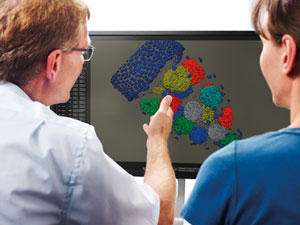Imaging, Analysis Software Platform for Life Science Research
LISTED UNDER:
 The easy-to-use Leica Application Suite X (LAS X) imaging software for life sciences from Leica Microsystems spans all widefield, confocal and super-resolution platforms. LAS X introduces new features for microscopic image acquisition, processing and analysis while maintaining established principles of its predecessor software LAS AF, such as the workflow-based approach. LAS X guides researchers intuitively through image acquisition, data recording and evaluation in live cell imaging, providing for a maximum of reproducibility as customized system settings can be saved. Its basic version is called LAS X Core and provides numerous functions.
The easy-to-use Leica Application Suite X (LAS X) imaging software for life sciences from Leica Microsystems spans all widefield, confocal and super-resolution platforms. LAS X introduces new features for microscopic image acquisition, processing and analysis while maintaining established principles of its predecessor software LAS AF, such as the workflow-based approach. LAS X guides researchers intuitively through image acquisition, data recording and evaluation in live cell imaging, providing for a maximum of reproducibility as customized system settings can be saved. Its basic version is called LAS X Core and provides numerous functions.
Further modules for specific applications such as high content screening, FRET, FRAP, multi-dimensional analysis, colocalization and measurements can be added. To further simplify widefield system usage an Easy Operation Mode is available where users can design their own user interface layout. The Dye Assistant for confocal microscopes helps select the right acquisition settings by just entering the used fluorescent markers.
The 3-D and the 2-D image analysis wizards generate reproducible analysis results from multi-dimensional data sets. Users are guided through the workflow step by step, from applying filters, thresholding, binary image processing through measurements and classification. Analyses between separate channels can be combined to obtain object-specific data. For example, a binary reference mask can be applied to count the number of spots in each nucleus. Within the 2D Analysis wizard, tracking experiments can be performed, and image analysis protocols can be combined with ImageJ macros. To save time, repetitive analysis protocols can be stored and applied to several experiments. Analysis results are saved with the experiment or can be exported to Excel for further investigation. The LAS X measurement function measures as well as documents distances, areas, volumes, angles and many other parameters.
Dedicated to live cell applications, the hardware-based Adaptive Focus Control (AFC) and the software-based autofocus are integrated in LAS X. Experimental conditions such as temperature, CO2 and O2 are documented and controlled with the Environmental Control module. For long-term time-lapse and screening experiments, the software-controlled micro dispenser compensates evaporation of water immersion. The MotCorr device can be used for software-controlled correction of image aberration. With the Mobile Connection module users can connect to the acquisition station via web client or mobile device and see the course of their whole experiment, review it, or open any image series available in the experiment tree. Experiments can also be started, paused or stopped remotely.
The basic version LAS X Core comes with features such as microscope control, full image viewer capability, diverse processing and quantification tools, movie export, the ability to recall imaging parameters and many more.
Leica Microsystems, www.leica-microsystems.com

